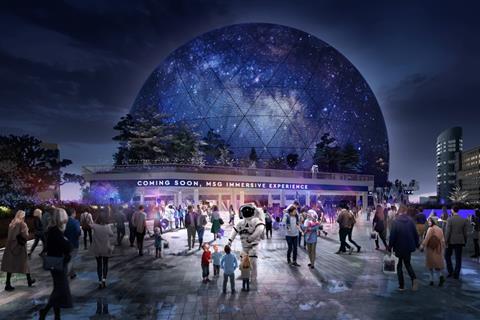Decision on Stratford scheme due next week
The controversial scheme to build entertainment giant Madison Square Garden Company’s first venue outside its US home in east London has been recommended for approval.
A planning report published by the London Legacy Development Corporation has told next week’s committee hearing on the proposal to give it the green light – despite the number of objections to the project being more than double those who support it.
It said 1,364 responses had been received with 852 opposing the plans, with the report adding that “recurring themes in opposition are the lack of need for the development as well as its scale, massing and form”.

The scheme has been designed by O2 architect Populous and will be wrapped in triangular LED panels which will show a range of static and moving images including digital art, promotional material for the venue itself – which will have a capacity between 17,500 and 21,500 – as well as adverts.
It is planned for a 1.9ha triangular site between railway lines next to the Westfield shopping centre and close to the London Stadium – the former Olympic stadium which was also designed by Populous and which is now the home of West Ham United.
O2 owner Anschutz Entertainment Group has called the scheme “seriously inadequate and flawed” and says the venue is in the wrong location given the London Stadium, the Copper Box as well as the O2 are all close by. AEG has said the scheme poses “a serious and dangerous impact on local transport infrastructure”.
In response, MSG said the 20,000-capacity O2 and the 12,500-capacity Wembley Arena were the only two venues in London capable of hosting bands that embark on world and European tours.
The proposals have stirred up huge controversy because of the building’s size and also because its entire skin will be covered in illuminated LEDs beaming advertisements in every direction around it – including into surrounding flats.
Historic England warned it would do some damage to nearby conservation areas because of its height, massing and “intrusive disturbance on their settings”.
But in a 209-page report, Daniel Davies, the principal planning development manager at LLDC, said the “development has been judged to be consistent with its town centre context and would diversify the cultural and night time offer”. It added there would “no direct harm” to heritage assets critics claim would be damaged such as the World Heritage Maritime Greenwich and several local, listed buildings including the grade II Stratford town hall.
And while it said there would be “inevitably some uncertainty as to the precise impacts” on transport infrastructure, it added: “These uncertainties are addressed through appropriate planning obligations, monitoring and commitments as necessary, to ensure further measures to mitigate any significant adverse effects are implemented.”
In conclusion, the report added: “Officers consider that the significant public benefits of the proposed development justify granting planning permission…with the proposed conditions and obligations to be secured by legal agreement [meaning] the impacts of the scheme can be neutralised or reduced to an acceptable degree.”
Building understands that the job is likely to be carried out as construction management scheme by MSG itself.
McLaren had been lined up to carry out the work, having beaten remaining Sir Robert McAlpine to the job three years ago.

But a rethink, prompted last year by the departure of Jayne McGivern, MSG’s executive vice president of development and construction, is understood to have concluded the CM route is the best option for such a technically complex job.
Among the technologies being promised by MSG are the largest and highest resolution LED screen in the world, an adaptive acoustics system to deliver crystal-clear audio to every guest, a haptic flooring system that will convey bass through the floor so that the audience can “feel” the experience and wireless connectivity that delivers 25 megabits per second for every guest to give greater interaction among fans.
A smaller 1,500 capacity venue is also planned at the Sphere site along with restaurant and retail space. The scheme will include building new bridges over neighbouring railway lines.
Others working on the scheme include planning consultant DP9, M&E engineer Me, acoustic engineer Arup and cost consultant RLB.
In a statement, MSG said: “We are pleased with the LLDC planning officer’s recommendation to approve the applications for MSG Sphere.”
Next week’s committee hearing will take place on 22 March, three years after it went in for planning.




























No comments yet